
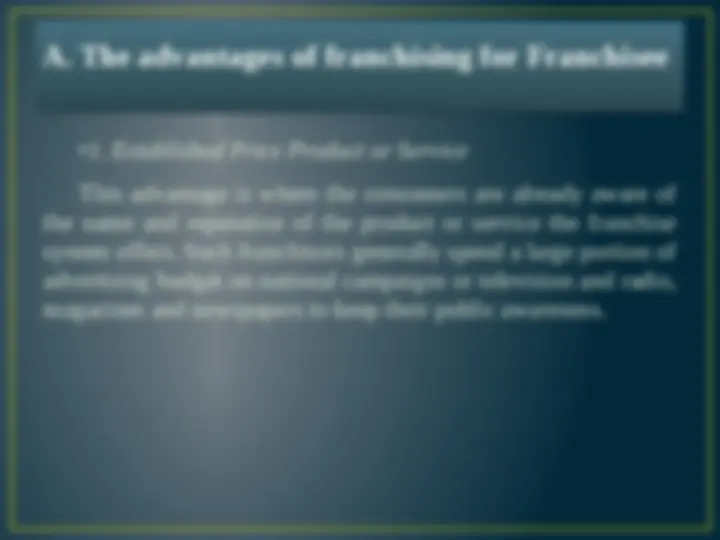



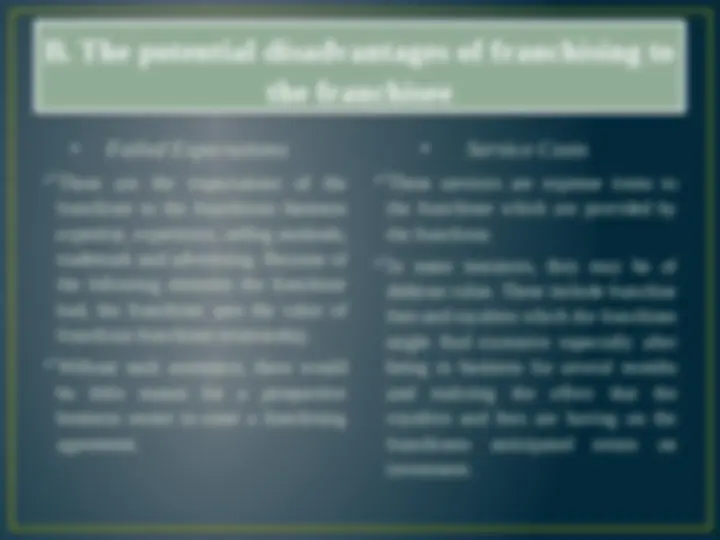

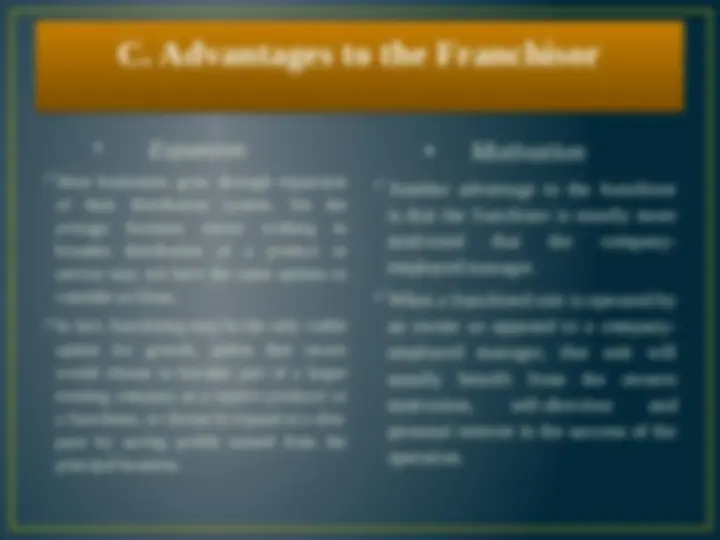
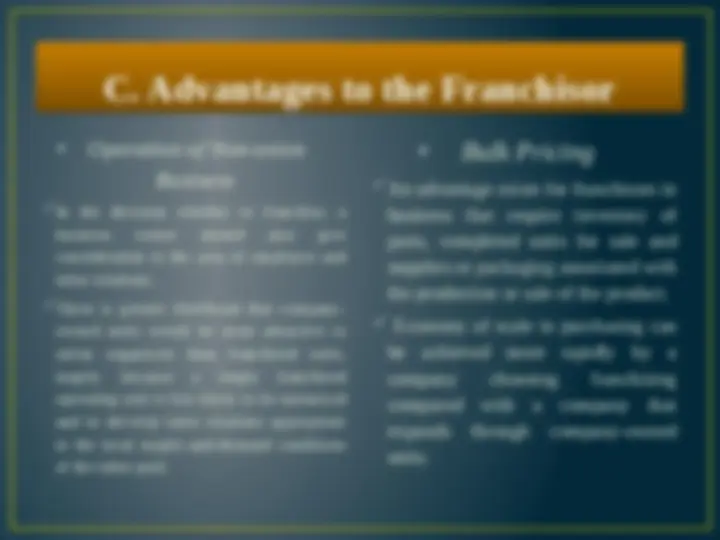


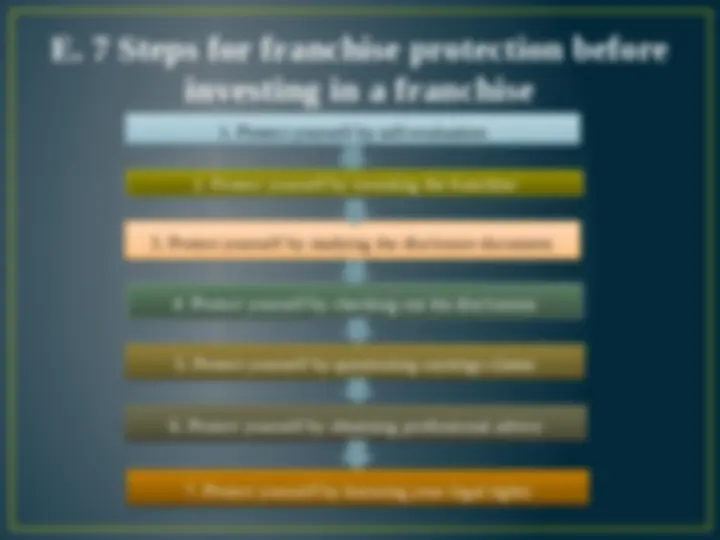




Study with the several resources on Docsity

Earn points by helping other students or get them with a premium plan


Prepare for your exams
Study with the several resources on Docsity

Earn points to download
Earn points by helping other students or get them with a premium plan
Community
Ask the community for help and clear up your study doubts
Discover the best universities in your country according to Docsity users
Free resources
Download our free guides on studying techniques, anxiety management strategies, and thesis advice from Docsity tutors
KEY POINTS: I. The advantages of franchising for both franchisor and franchisee II. The potential disadvantages of franchising to the franchisor and the franchisee III. The seven steps for franchise protection before investing in a franchise IV. The typical elements included in a franchising agreement
Typology: Slides
1 / 21

This page cannot be seen from the preview
Don't miss anything!














2. Technical and Managerial Assistance
This type of advantage is provided by the franchisor. The new
franchisee will receive technical assistance which often includes
location and site selection, store layout and design, store
remodeling (if the franchisee is converting an existing site),
inventory purchase and control methods, equipment and fixture
purchasing or leasing and assistance with the grand opening of
the new franchise business
3. Quality Control Standards
This third type of advantage is again provided by the
franchisor. By setting and maintaining high standards, a franchisor
does the franchisee a genuine service. Properly administered and
controlled, such standards help the franchise to achieve positive
results by ensuring product service uniformity throughout the
franchise system.
5. Opportunity for Growth
This fifth potential advantage concerns growth opportunities
for operating a territorial franchise. A territorial franchise
guaranties no competition from the same franchisor within a
specified geographic boundary. It may later be in a position to
sub franchise or license other persons to operate stores
belonging to the territorial franchisee. If a new franchised
company is enjoying successful growth, its franchisees could
have more opportunity for financial gain as territorial
franchisees.
B. The potential disadvantages of
franchising to the franchisee
This type of disadvantage again
points to the franchisor-franchisee
relationship.
A franchisee can become too
dependent on the advice of the
franchisor to address operations,
crises, changing market conditions,
pricing strategy or promotions and
so may fail to apply common sense
and knowledge of local customers
and market conditions.
Ownership
The franchising contract may
contain restrictions or requirements
that an independent business person
would not have to satisfy. For
example, territorial restrictions
imposed by the franchisor may limit
the potential customer contacts a
franchisee might see or territories
may overlap or be inequitably
determined by a franchisor.
B. The potential disadvantages of
franchising to the franchisee
B. The potential disadvantages of
franchising to the franchisee
This is the least-considered potential
disadvantage to the franchisee. If the
franchisor becomes lax in managing the
franchise system or does not enforce the
quality standards imposed throughout the
network, poor performance by some in the
franchise network can affect the sales of
others.
Usually, a customer of a multiunit
franchised company will tend to blame the
entire franchise and nit the single operating
unit for poor service or low quality.
C. Advantages to the Franchisor C. Advantages to the Franchisor
Most businesses grow through expansion
of their distribution system. Yet the
average business owner wishing to
broaden distribution of a product or
service may not have the same options to
consider as Sloan.
In fact, franchising may be the only viable
option for growth, unless that owner
would choose to become part of a larger
existing company as a captive producer or
a franchisee, or choose to expand at a slow
pace by saving profits earned from the
principal business.
Another advantage to the franchisor
is that the franchisee is usually more
motivated that the company-
employed manager.
When a franchised unit is operated by
an owner as opposed to a company-
employed manager, that unit will
usually benefit from the owners
motivation, self-direction and
personal interest in the success of the
operation.
In the decision whether to franchise, a
business owner should also give
consideration to the area of employee and
labor relations.
There is greater likelihood that company-
owned units would be more attractive to
union organizers than franchised units,
largely because a single franchised
operating unit is less likely to be unionized
and to develop labor relations appropriate
to the local supply-and-demand conditions
of the labor pool.
An advantage exists for franchisors in
business that require inventory of
parts, completed units for sale and
supplies or packaging associated with
the production or sale of the product.
Economy of scale in purchasing can
be achieved more rapidly by a
company choosing franchising
compared with a company that
expands through company-owned
units.
D. Disadvantages to the Franchisor
Potential Problems
RECRUITMENT
COMMUNICATION
communication problems can arise. In
franchising, a franchisee may develop
a sense of independence and no
longer feel a need to rely on the
franchisor for the successful operation
of the business; he or she may
conclude that the business would run
just as smoothly without the
franchisors advice and seek to
discontinue the relationship.
LOSS OF FREEDOM
can easily make decisions and
change policies within their
organizations; but once a
franchise system is developed,
the franchisor or parent
company must get permission
from franchisees to introduce
new products, to add or
eliminate services, or to
change operating policies.
D. Disadvantages to the Franchisor
Potential Problems
E. 7 Steps for franchise protection before
investing in a franchise
. The typical
elements
included in a
franchising
agreement
. The typical
elements
included in a
franchising
agreement